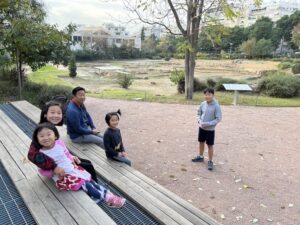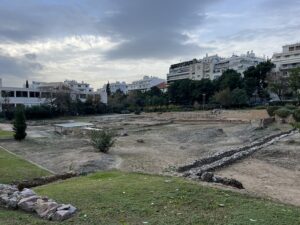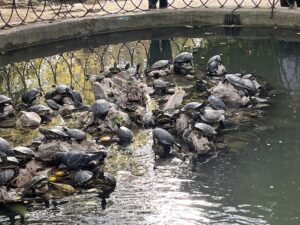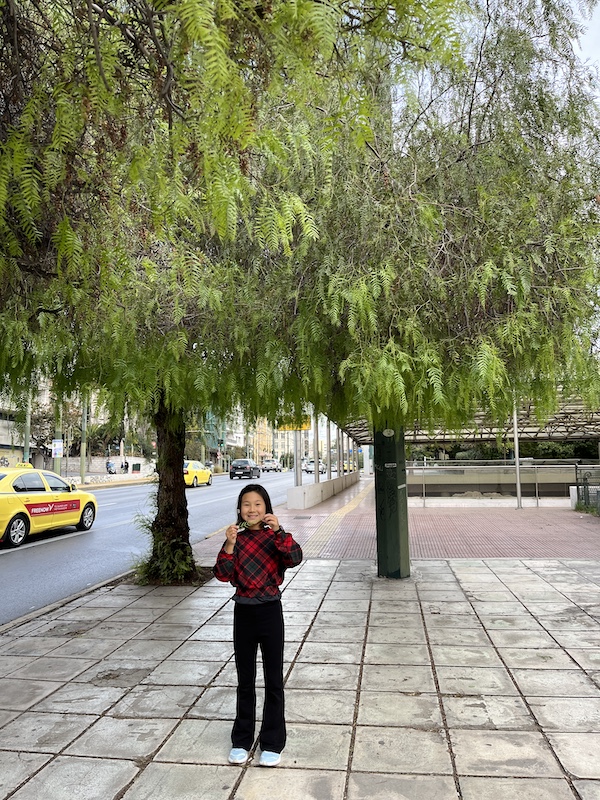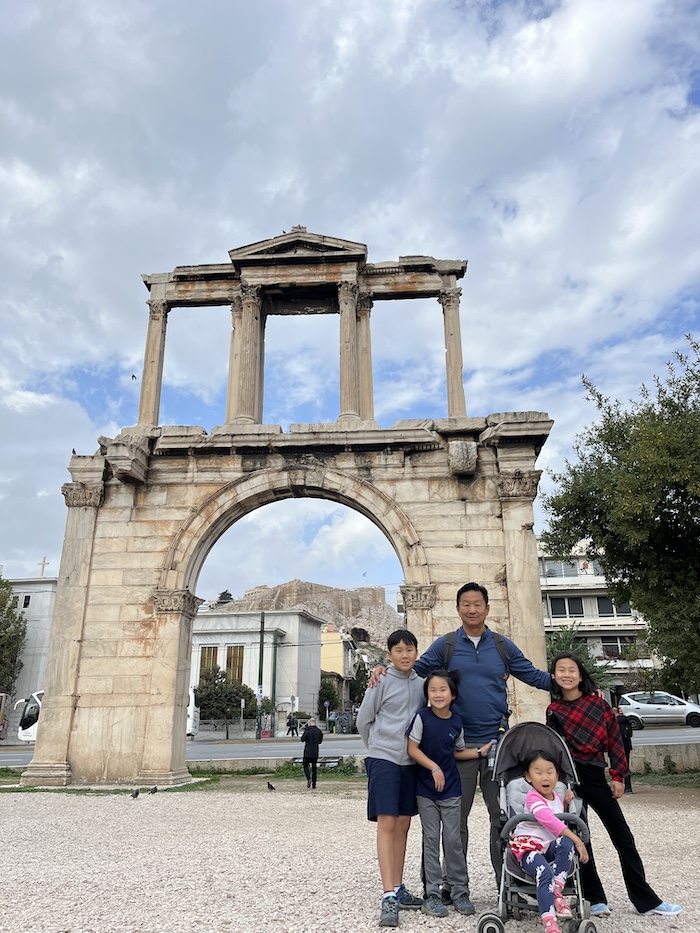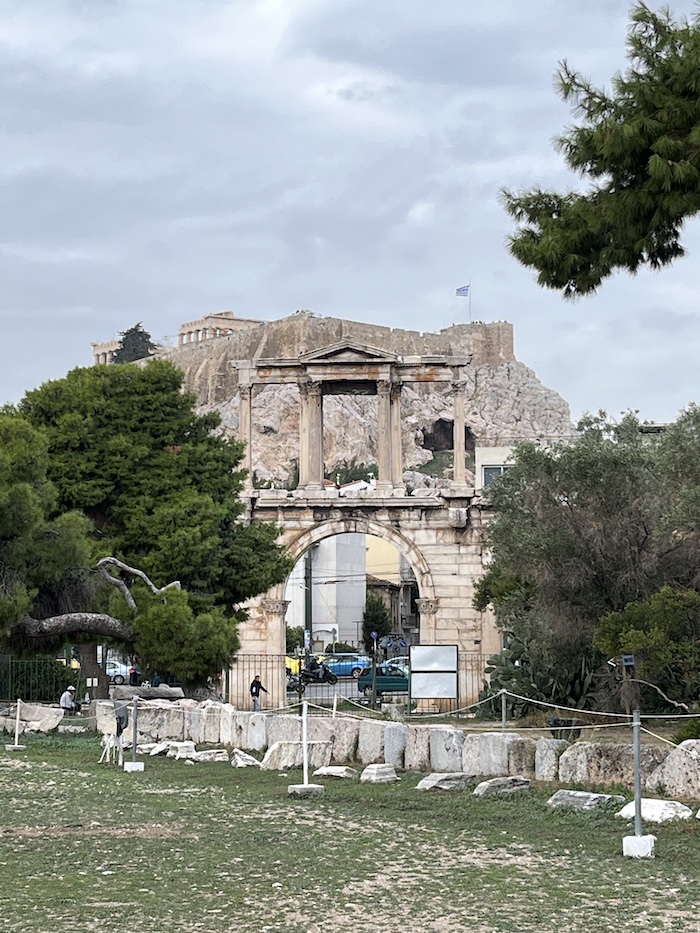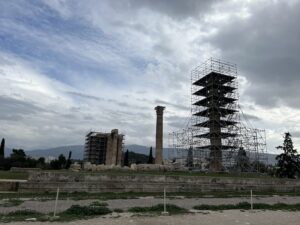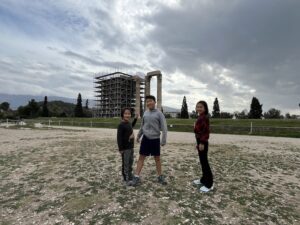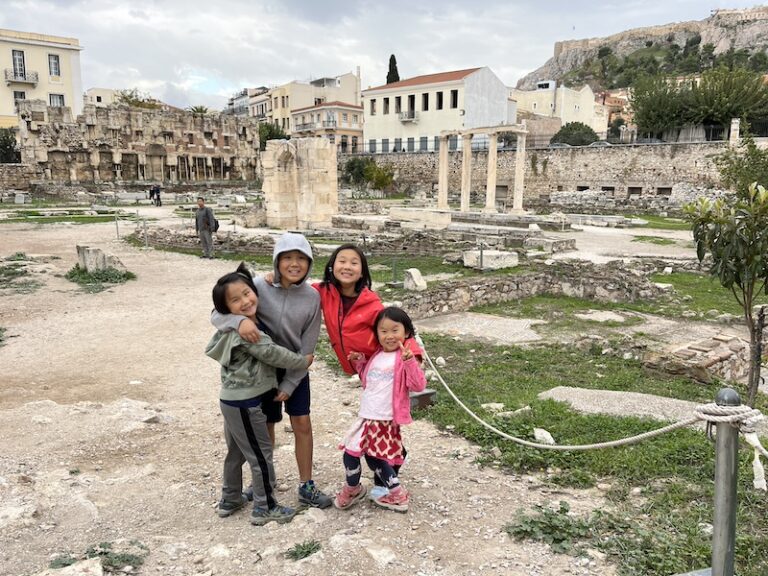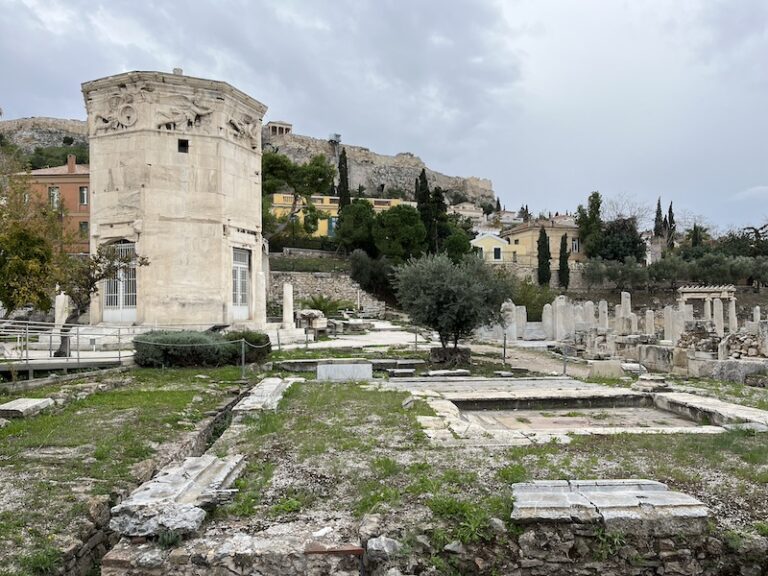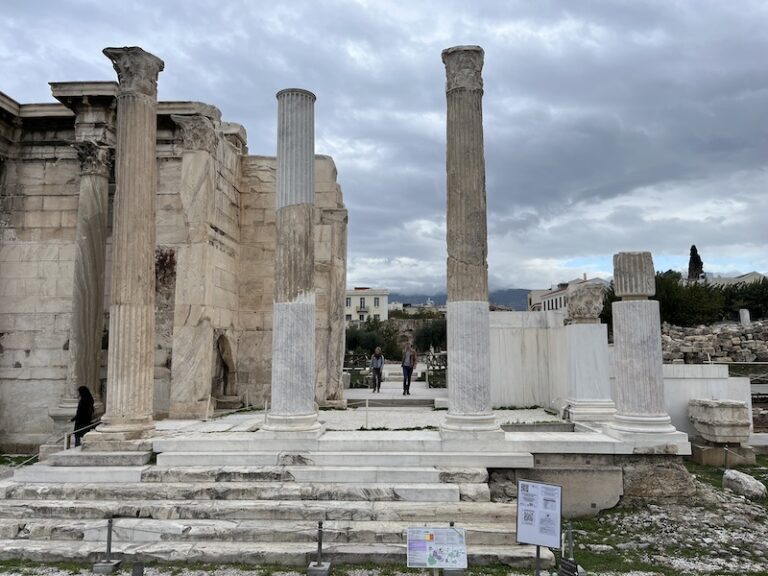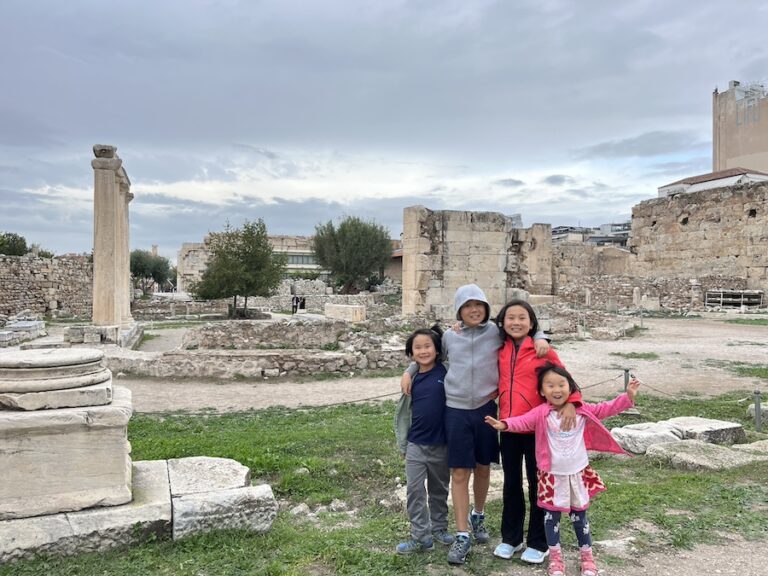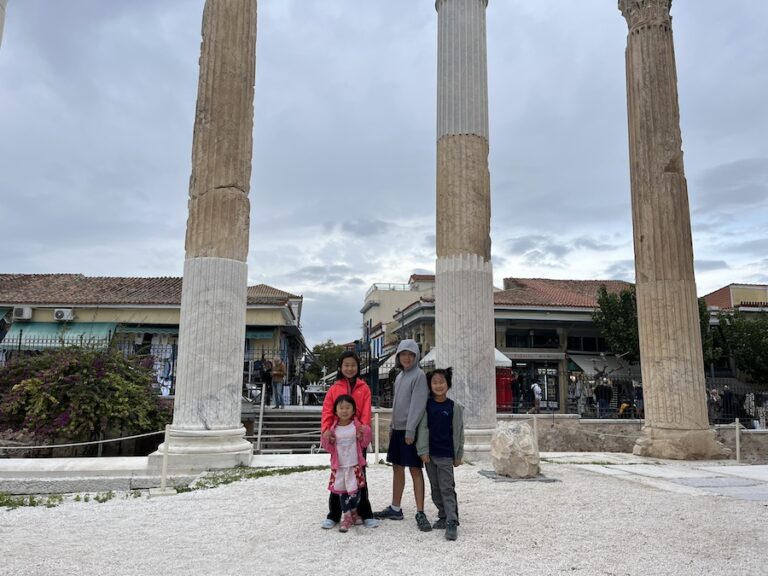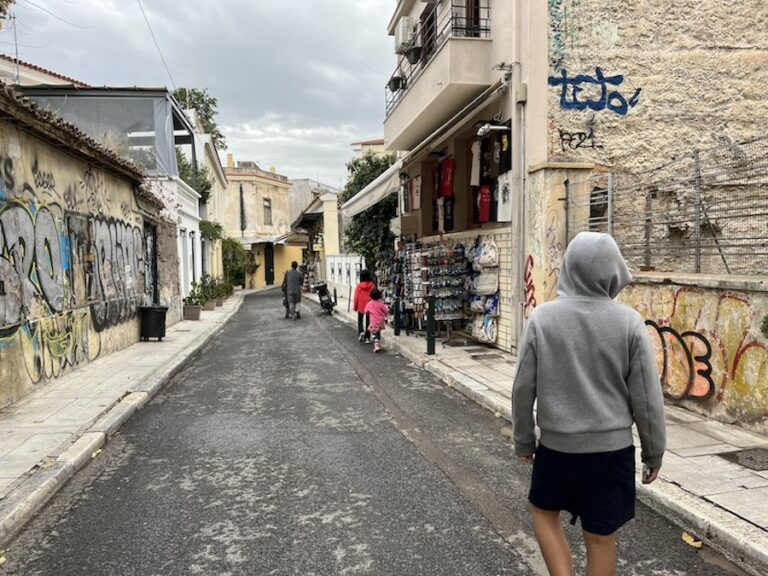In lieu of hiring a guide to take us through some of the smaller ancient sites scattered around Plaka, RY gamely offered his services to plan our route and guide us through Aristotle’s Lyceum, Arch of Hadrian, Temple of Olympian Zeus and Hadrian’s Library. He planned for us to travel on foot from east to west, starting from the easternmost site, Aristotle’s Lyceum, and ending at Hadrian’s Library in the heart of Monastiraki.
Aristotle's Lyceum
Founded in 335 BC, the Lyceum is the school where Aristotle, one of the greatest philosophers of all time, composed and taught. At the Lyceum, Aristotle explored and taught wide ranging topics as diverse as physics, human biology, animal biology, metaphysics, logic, ethics, politics, poetry, rhetoric and philosophy.
On the day that we visited Aristotle’s Lyceum, we had the whole place to ourselves. What remains of the Lyceum amounts to not much more than a few foundation stones. We didn’t mind because we could see that even with scant ruins of archaeological significance, it is a beautiful and peaceful place with a very special history.
During our visit to Aristotle’s Lyceum, RY volunteered to be our guide. RY came prepared to teach but his students became distracted by the mosquitoes.
Rand shared with us some information about Aristotle’s unique teaching style. His school was known as a Peripatetic School because of Aristotle’s liked to teach while walking through the gardens.
Aristotle was the student of Plato, who was the student of Socrates. To supplement some of RY’s guiding, we watched a few youtube videos to better understand some of Aristotle’s main ideas.
While there was deep mutual respect, Plato and Aristotle differed in approach and opinion on many ideas. Whereas Plato preferred to rely on philosophical conclusions and reasoning to prove something, Aristotle preferred direct observation and experience. Whereas Plato’s approach was abstract and utopian, Aristotle’s approach was more practical and based on commonsense. Aristotle developed an approach based on three concepts – function, classification and hierarchy, to explain everything. You can see how this forms the foundation to a scientific approach.
Aristotle’s parents died when he was young and he was likely raised by relatives. When he turned 17, he was sent to study under Plato, where he stayed for 20 years. A few years after Plato’s death, Aristotle, who was already a famous philosopher, was invited to Macedonia by King Phillip II, to tutor his 13-year-old son Alexander and the children of Macedonian nobles. For three years, Aristotle tutored the boy who would become Alexander the Great and many of the future generals of the Macedonian army.
When Aristotle returned to Athens, he rented a space at the existing Lyceum which was at the time, a gymnasium for training men in wrestling. Aristotle strongly believed in the link between a healthy body and a healthy mind. During Aristotle’s residence at the Lyceum, both philosophical pursuits and physical exercise were practiced.
We walked around the path of the Lyceum much like Aristotle must have done with his students, enjoying the peaceful surroundings. Without anybody around to disturb, I allowed the kids to run ahead. The air was fresh and cool. The sky was overcast and the clouds were gathering overhead.
National Garden of Athens
We weren’t planning on visiting the National Garden of Athens but it was the shortest walking path to cut through the National Garden from Aristotle’s Lyceum to reach the Arch of Hadrian.
The National Garden covers 16 hectares and is the largest park in Athens. In ancient times, it was a private garden for the philosopher and naturalist Theophrastus of Eresos. The first Queen of Greece, Queen Amalie wife of King Otto, selected it as the site for the royal garden. It was designed to be both a private retreat and a horticulture garden used for science. In 1923, it was renamed the National Garden and opened to the public.
We entered the National Garden from the northeast corner and meandered through a walking path where we spotted a very large nest in the branches of a towering tree. We walked a bit further and came across a turtle pond with hundreds of red-eared sliders. When I was a child, I had a pet red-eared slider that I named Nigel. One day when I was cleaning out his tank in the back yard, I left him on the pavement to soak up some sun. While I was busy scrubbing the glass tank, he walked off and I was never able to find him. I always imagined Nigel living his best life somewhere between the giant pepper tree and the juniper bush in our backyard.
We walked through some lovely paths in the park and eventually emerged out on the street beneath some pepper trees just like the one in the backyard of my parent’s house. I could recognize a pepper tree even with my eyes closed because of its distinct earthy scent. We followed the map to the Arch of Hadrian, also known as Hadrian’s Gate. En route, we passed a bronze statue of Alexander the Great atop his beloved steed, Bucephalus. Legend has it that as a boy, Alexander was able to tame Bucephalus when nobody else could, by turning its head toward to sun so it would not be frightened of its own shadow. The statue was created in 1993 by the sculptor Giannis Pappas and shows Alexander as a teenager, before he became a powerful leader. It was relocated to this much more visible position in 2019 from its original location near the sculptor’s workshop.
Arch of Hadrian
The Arch of Hadrian is a monumental marble archway built by Athenians in 131-134 AD in honor of the Roman emperor Hadrian. It was originally built on an ancient road that led from the Acropolis and the Ancient Agora to the Temple of Olympian Zeus. There are inscriptions on either face of the arch. On the western side of the arch, facing the Acropolis, it reads, “This is Athens, the ancient city of Theseus.” On the eastern side of the arch, facing the Temple of Olympian Zeus, it reads, “This is the city of Hadrian and not of Theseus”. These inscriptions are commonly interpreted to mean that the arch marked the boundary between “ancient Athens” and “new Athens or Roman Athens”.
It had been sprinkling just a bit as we walked toward the arch, but the rain stopped and when the clouds allowed the sun to peek through, it cast a brilliant light on the Pendeli marble that gave it a luminescent quality. The Arch of Hadrian seemed to be standing on its own in the middle of nowhere. One might assume that it was the gate of a longer wall structure, but it never was. It was always just a stand-alone monument.
We rested on a bench with a view of the arch as our guide, RY, shared some salient information with us. We got up and walked beneath the arch a few times, snapped a few photos and proceeded on.
Temple of Olympian Zeus
The Temple of Olympian Zeus is just behind the Arch of Hadrian. At the moment, the area looks like a construction site. Only a few of the remaining columns are visible with the rest hidden behind scaffolding as they undergo restoration work. It is the first time major maintenance work is being performed to the temple to remedy issues of structural stability and deterioration.
The temple was once the largest in Greece with 104 Corinthian columns that towered at 17 meters in height. The temple took over 700 years to build because its construction started, stalled and stopped several times. It was originally begun in the 6th century BC by Peisistratos and only completed in 131 AD by Hadrian. Inside the original temple, besides a colossal gold and ivory statue of Zeus, Hadrian included an equally enormous statue of himself.
Over the ages, the columns and materials from the temple were used in other building works so today, only 15 columns remain at the site. There is one other collapsed column that fell in a storm in 1852.
During our visit, the sky was growing darker by the minute with rain clouds gathering, impatient to let out bursts of moisture. This is probably how it looks just before Zeus hurls his lightning bolt to punish some poor unsuspecting mortal. We were the only visitors and we walked around the periphery of the temple. The kids were invigorated by the possibility of rain. I looked up at the sky a few times and couldn’t resist searching for an image of Zeus in the clouds.
Hadrian's Library
The library was built by Hadrian in 132-134 AD, around the same time he was working on other buildings and monuments around Athens, including a couple that we visited, the Arch of Hadrian and the Temple of Olympian Zeus. When it was completed, it was the largest library in Athens and was used to store important books and documents, usually written on papyrus scrolls. There were also a host of rooms to hear lectures and enjoy art and music.
Through the ages, the library suffered damage and underwent repairs. In the 5th century AD, a church was built on the site and then destroyed and replaced with another church, just to have that one destroyed and replaced with another one during Byzantine rule. During Turkish rule, the library was converted to an administrative center again and housed the Turkish Administrator of Athens. Around the 15th century AD, it was the site of bazaars. By the 18th century AD, it was a mosque and a fortress. In the 19th century AD, it served as army barracks and even a prison.
Hadrian’s Library would be our last sightseeing spot for the day. The rain had been on and off for the past few hours, luckily no more than a sprinkle. Just as well because our legs were tired and the children were losing focus. We did our obligatory walk through the archaeological ruins, snapped a few photos and called it a day.
Author
-

Song is the mother of four children. She and her family have stepped away from it all and in September 2023, began traveling the world while homeschooling. Song is an ABC (American born Chinese) and has an undergraduate degree from Cornell and an MBA from Harvard. She is an entrepreneur and an educator. Her hobbies include learning, traveling, reading, cooking and baking, and being with children.


